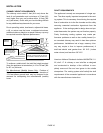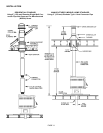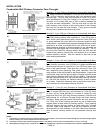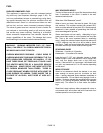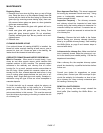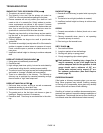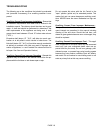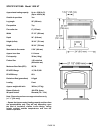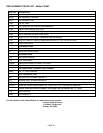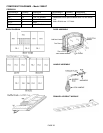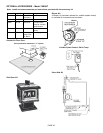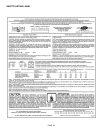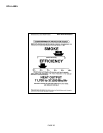TROUBLESHOOTING
PAGE 18
SMOKES OUT FUEL DOOR WHEN OPEN (see ✸)
1. The primary air control is closed.
2. The chimney is too cool. Set the primary air control on
"HIGH" for a few minutes before opening the fuel door.
3. Excess creosote will not only restrict your draft but it will
create a risk of a creosote fire. Strictly adhere to mainte-
nance requirements as outlined in this manual. If excess
creosote has built up on the inside of the firebox sides and
door, burn a small hot fire at intervals that are more fre-
quent with air control on HIGH for a few minutes.
4. Deposits may have built up in the chimney and are restrict-
ing the draft, or the spark arrestor on top of the chimney
may be plugged.
5. Chimney diameter too large or too small to provide ade-
quate draft.
6. The house is too airtight (usually takes 20 to 30 minutes for
problem to appear as stove lowers air pressure in house).
Crack a window open or provide an outside source of air
near stove.
7. Insufficient vertical height to chimney to achieve adequate
draft.
DOES NOT PRODUCE ENOUGH HEAT (✸)
1. Using green or insufficiently cured wood.
2. Excessive draft.
3. High ceilings (heat rises quickly, but can be recirculated by
a well-placed ceiling fan with a winter/summer switch).
4. The area to heat is too large (square foot heating estimates
are based on "average" climates and home design).
5. There is an obstruction in the chimney. The chimney or
chimney cap is restricted by creosote preventing enough
draw to sustain a "high" heat output rate.
DOES NOT MAINTAIN A FIRE (✸)
1. Soft wood does not burn as long or as well as seasoned
hardwood resulting in a short burn time.
2. Wood size too small. Burns at too rapid a rate.
3. The gasket seal on the fuel door, ash drawer or glass is
leaking air. Repair or replace it if necessary.
4. Excessive draft. There may be an obstruction in the chim-
ney.
BACKPUFFING (✸)
1. Downdraft in the chimney (a special wind cap may be
needed).
2. The house is too air tight (ventilation is needed).
3. Insufficient vertical height to chimney to achieve ade-
quate draft.
ODORS
1. Creosote accumulation in firebox (brush out on next
cleaning).
2. Chimney downdraft when stove is not operating
(close the primary air control).
3. Paint curing on first several burns.
DIRTY GLASS (✸)
1. Poor draft conditions.
2. Long burn periods at low draft settings.
3. Burning wet, pitchy or spongy wood.
4. Poorly arranged logs (too close to glass).
(✸) Draft problems; if installing into a larger flue, it
may be necessary to use a full length liner to
achieve adequate draft for the appliance. A draft
gauge should read a minimum of .05" w.c.
(inches water column) not to exceed .07" w.c.
for optimum performance (See Draft Require-
ments, page 10).
OVERFIRING DAMAGE
If the heater or chimney connector glows, you are over-
firing. Other symptoms may include: Cracking, warping
or burning out of components, stove glass may develop
a haze, which will not come off with cleaning.
Overfiring of a stove is a condition where excessive tem-
peratures are reached, beyond the design capabilities of
the appliance. The damage that occurs from overfiring is
not covered under the manufacturers limited warranty.



